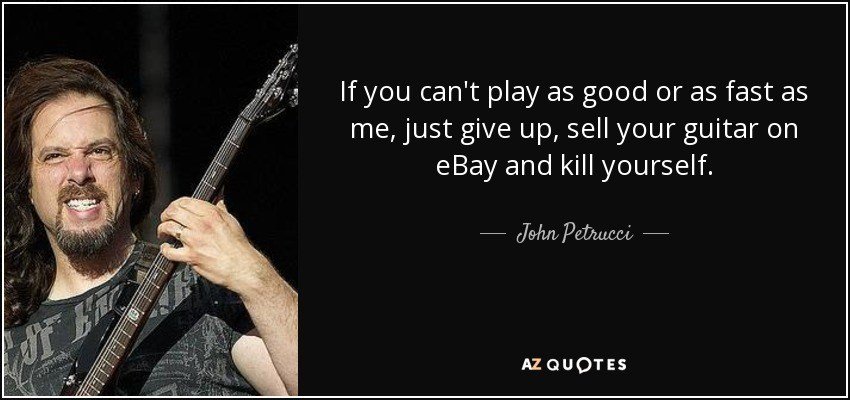Many guitar students are impressed by more advanced players who can play very rapidly and generate great flurries of notes. Usually, these are players with excellent technique who make this type of fast playing appear effortless as if their hands are magically floating over the strings. I’m sure we all remember the moment we first saw somebody play like that right in front of us.
What most of us didn’t realize back then, and maybe still don’t, is that good guitar technique is a learned skill and there is a well-worn path to developing it. Any musician with chops has spent time in the woodshed creating them.
It’s really a pretty simple thing to do, you just need to practice a lot and keep it going for a long time. In other words, it requires musical discipline.
In the following article, I will explain the basic ideas behind building good technique that you can apply in your own practice sessions. Keep at it and you will see your overall speed go through the roof!
Why Can’t I Play Fast?

This is one of the most common questions I get asked as a guitar teacher. The quest for speed is very important to some students because playing fast is impressive and fun and some musical styles, like Metal, pretty much require guitarists to be able to rip.
Faq: So how do we get this ripping done?
The answer often seems counter-intuitive to most people but it is the truth, nonetheless.
No matter how someone might play the guitar, with a pick, fingerstyle, 8-finger tapping, slapping, whacking, or whatever, clean notes are produced when both hands move at EXACTLY the same time, in sync. Mistakes occur when the synchronization is broken. Getting both of your hands moving together is the most basic part of playing fast notes.
I know, I know, everybody hates that things clicking away at themselves but it is the only real way to develop skills that stick. There are tons of choices of metronomes you can buy and there are also lots of free metronome sites you can find online. Pick one and get ready to use it.
Here is a metronome site – my favorite web-based tool.
The Most Fundamental Exercise
The basic idea here is to pick a couple exercises and use them to get cozy with your chosen metronome. One of the most important drills is the Chromatic Fours Exercise. It looks like this:

This is basic guitar technique in a nutshell. Four frets, four fingers, or what we call: A Position. First finger at the first fret means First Position, first finger at the second fret is Second Position, and so on.
Your Turn
- Set your metronome at 60 Beats Per Minute (BPM).
- The first object of the game is to play a note perfectly on every click.
- Use downstrokes.
- Your notes need to be right on time with the click so that your notes and clicks kind of merge together. You don’t want to be slightly ahead or behind the clicker.
GOAL: doing this on auto-pilot with zero mistakes at 60 BPM.
Beginners can run this up and down in First Position only if they are not comfortable shifting positions the way the TAB shows. What matters is being able to do this perfectly over and over, which sounds a lot easier than it is.
Practice Tips
- Be aware if you are tensing up your muscles too much, as this is a sign of trying too hard. You need to be able to do this with loose muscles.
- When you can, bump your metronome up one increment and start over again.
- Practice until you can hold a conversation with someone and play this drill at the same time.
Beyond The Basics
This is how the whole metronome thing works and you will do it with other drills, patterns, and songs as you improve your playing. When we play this one note per click, we are playing Quarter Notes, which are one full beat each and played with all downstrokes.
The first change you are going to make to this drill is to play two notes per click using Alternate (down and up) Picking. These are now Eighth Notes. They are half a beat each. The first note will fall on the click with a downstroke and the second will fall in the silence between the clicks and be played with an upstroke.
Slow your metronome down if needed, as you want to keep this all perfect. Doing it sloppily won’t help your speed at all. It will just make your mistakes permanent.
Here is a video to show you what it looks like:
Work on this for at least 15 minutes each time you practice and you will start seeing, hearing, and feeling results in a few weeks. This really is small-muscle athletics and you are in training, so you can expect the same rate of results as you would going to the gym to lift weights. Do this for two days and nothing much will happen. Do this daily for a year and you will amaze yourself with how much faster and cleaner you’ve become.
Get Faster!

The next step is getting this down at four notes per click, which are Sixteenth Notes. They are one-quarter of a beat each and played with Alternate Picking, just like Eighth notes.
Adjust your tempo as needed to maintain cleanliness. Find the speed where you are comfortable with each drill and work your metronome up in speed one notch at a time until you can’t play cleanly anymore. Keep track of your range of tempos over a year or so of good practicing and you’ll see that top number get higher and higher.
Practice Tips
As you improve, you can also try pushing past your top tempo by three to five BPM for a few minutes and then returning to your normal top speed. A good rate of improvement to have as a goal is about three BPM each week.
You will now use this method of practicing with all of the scales and patterns that you play. The best thing you can do is never practice without the metronome, no matter what. Get used to playing well and locking in with an external source of time.
Doing this for a while will result in you always playing with your hands moving perfectly together without you having to think about it. That’s the real first step in getting your speed up on any instrument. You have to work the bugs out of your technique so the music can emerge.
Conclusion
We hope you enjoyed this guitar lesson on how to play faster. Please let us know if you did in the Comments section below.
Remember, learning how to play guitar faster takes time and determination. Anyone who can do it has put in their time and you’ll have to do the same if you want the same results. Be patient with yourself, refuse to quit, and enjoy each small victory. Before you know it, you’ll be playing at top speed!